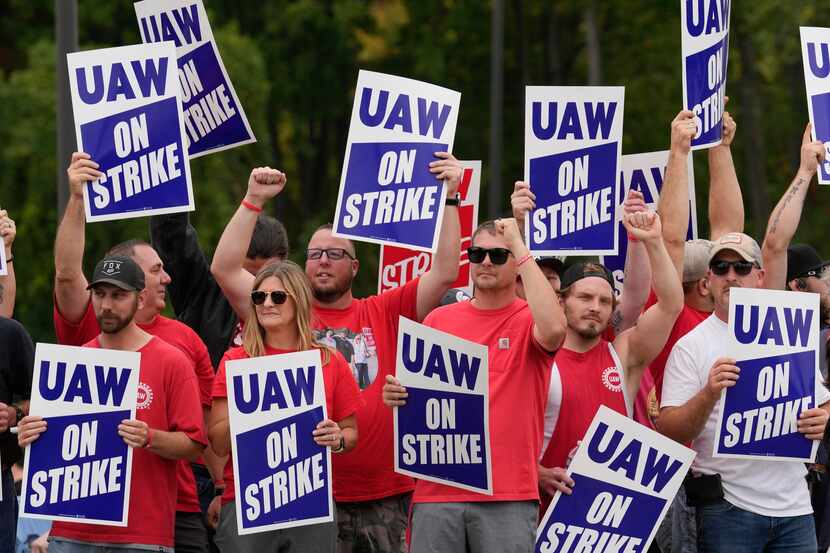General Motors increased its pay offer to the United Auto Workers on Friday in an effort to end a strike of Detroit’s three automakers.
In a statement, GM said it made an offer with “substantial movement in all key areas in an effort to reach a final agreement with the UAW and get our people back to work.”
The company said its offer raises pay for most of the workforce to $40.39 an hour, or about $84,000 a year by the end of a four-year contract. That’s a 23% increase over the $32.32 an hour that most factory workers make. Compounded annually it’s 25%.
GM also said it will reinstate cost of living raises for many employees in the first year of the contract, boosting the pay increase to over 30% by September 2027. Workers gave up the inflation-fighting raises in 2007 when the companies were in financial trouble.
In a livestream Friday, UAW President Shawn Fain said he thinks the union can still win more from GM, Ford and Stellantis. He urged the 34,000 striking workers at six vehicle assembly plants and 38 parts distribution warehouses to remain strong as union leaders try to push a record contract over the finish line.
He also told non-striking workers to “be ready to stand up” if the UAW announces new strike targets. He recently credited a threatened strike at GM’s Arlington assembly plant, where some 5,000 workers make highly profitable SUVs, with moving negotiations forward with the automaker.
GM agreed to include its future electric vehicle battery plants under the UAW contract, which the union hailed as a major concession.
Marick Masters, a business professor at Wayne State University in Detroit, said the GM offer has the potential to be a breakthrough that could bring agreements to end the strike. “That moves them closer, and I think that it may not take much from that point,” he said.
In order to settle with all three, Masters said, Ford and Stellantis will have to join GM in essentially agreeing that factories of the future would be represented by the union.
The union’s strikes at targeted plants at each company began Sept. 15 and are nearing the start of their sixth week. About 23% of the union’s 146,000 members employed by the three automakers are striking.
The UAW had been seeking 36% raises over four years.
It’s also seeking restoration of defined benefit pensions that workers gave up in the Great Recession, pension increases for retirees, an end to varying tiers of wages for workers and other items. GM’s offer appears to end the tiers in the last year of the new contract.
GM said Thursday that it can’t give Fain everything he wants because it needs profits to invest in future vehicles and factories. Ford and Stellantis have made similar comments, with Ford saying it has reached the limit on how much it can spend to settle the strike.
The union, however, says labor expenses are only about 5% of a vehicle’s costs, and the companies can divert money from profits and stock buybacks to pay for raises that cover inflation and make up for years of contracts without significant increases.
Ford Motor Co., which was caught directly in the UAW’s line of sight last week, had an unexpected appearance this week from the company’s executive chair, William Ford. He’s the great-grandson of company founder Henry Ford
He called on the union to end the strike in a rare move during contract talks.
“The UAW’s leaders have called us the enemy in these negotiations. But I will never consider our employees as enemies. This should not be Ford versus the UAW,” Ford said. “It should be Ford and the UAW vs. Toyota and Honda, Tesla, and all the Chinese companies that want to enter our home.”
Fain disagreed.
“Bill Ford knows exactly how to settle this strike,” the UAW’s leader said in a statement. “If Ford wants to be the all-American auto company, they can pay all-American wages and benefits. Workers at Tesla, Toyota, Honda, and others are not the enemy – they’re the UAW members of the future.”
Stellantis, the automaker behind popular brands like Chrysler, Dodge and Jeep, is looking to leave or downsize its U.S. home base in Auburn Hills, Mich., in a cost-saving move. It also announced it’s pulling out of the Los Angeles Auto Show and Specialty Equipment Market Association trade show, SEMA, due to the strike.
“As the costs of the ongoing UAW strike continue to mount, Stellantis has decided to cancel its planned display and all other presentations ... as part of its contingency plan,” the company said in a statement.
Stellantis is also pulling out of the 2024 CES event in Las Vegas, Nev., an important show for the company. It revealed the Ram 1500 Revolution battery-electric vehicle concept at last year’s show.
East Lansing, Mich.-based economic consulting firm Anderson Economic Group described the contract talks as entering the “danger zone.”
“Without a settlement soon, a plausible restart with higher costs will likely lead to some permanent losses of production, and suppliers that will need financial assistance to return to operation,” said Patrick Anderson, AEG’s principal and CEO.
Through four weeks, the strike has cost the national economy $7.7 billion in lost wages to workers, dealers, customers and other losses to the industry, according to the firm.
“Most of these costs are being borne by workers and by small- and medium-sized businesses, not by the Detroit 3,” Anderson said.



/cloudfront-us-east-1.images.arcpublishing.com/dmn/RY3MWRZU5VD6PDXY6ZPRB7TJRY.jpg)
/cloudfront-us-east-1.images.arcpublishing.com/dmn/X4BAMR4XJ5DABIFYSWYL2EJIAQ.JPG)
/cloudfront-us-east-1.images.arcpublishing.com/dmn/E2AVVAIQ6ZHZXHS2CIFWGS2TEQ.jpg)
/cloudfront-us-east-1.images.arcpublishing.com/dmn/BY27BGG4NBGR7FCPZSGLDLE7FM.jpg)
/cloudfront-us-east-1.images.arcpublishing.com/dmn/OHJLZ6OUD7HLG66L3W3VU4WXFA.jpg)